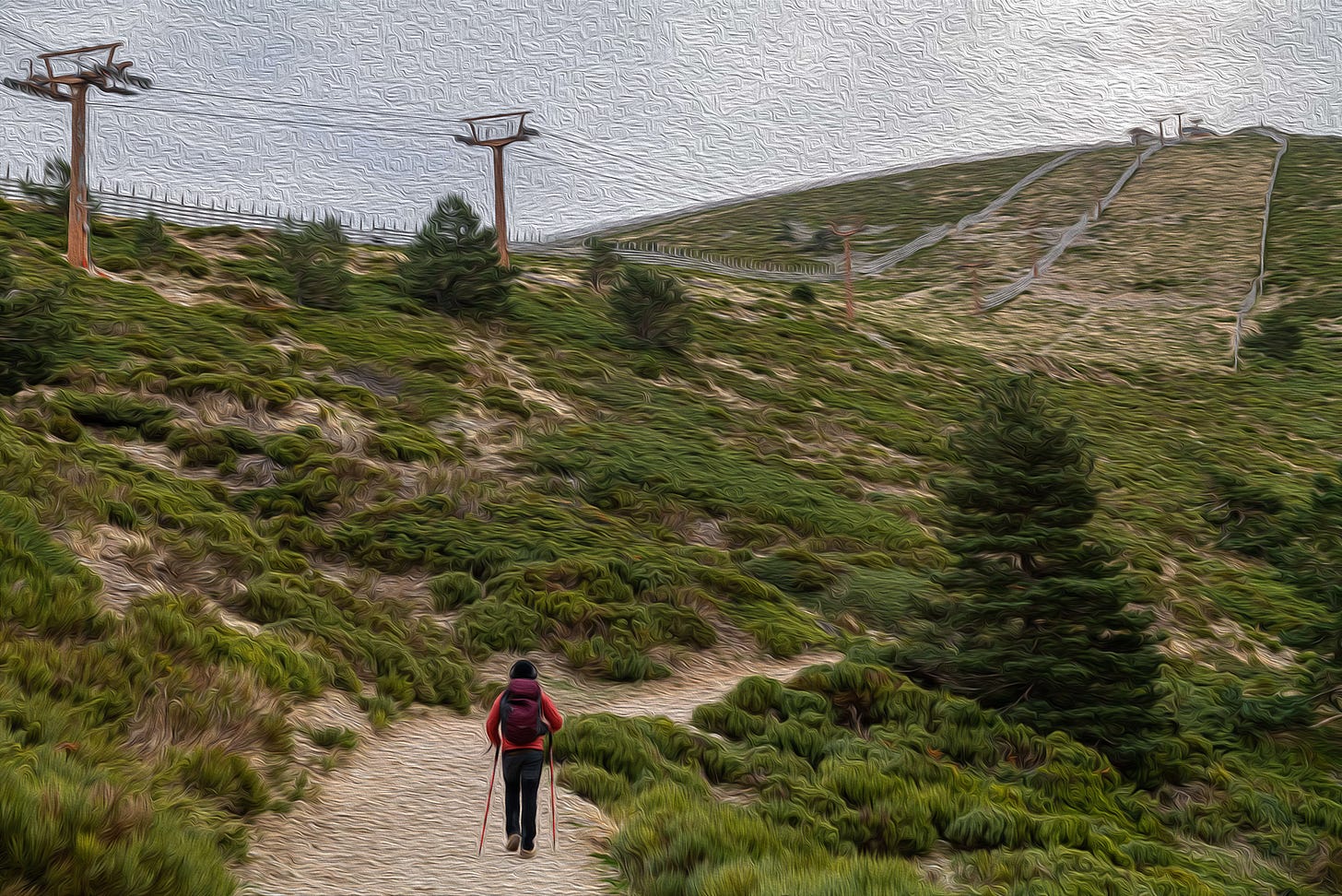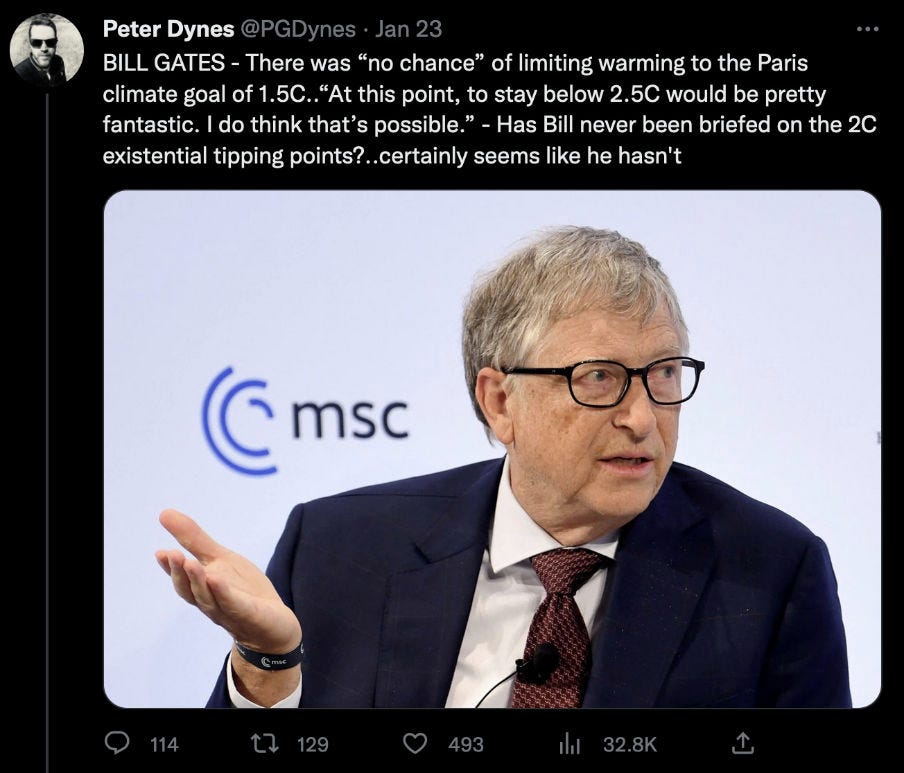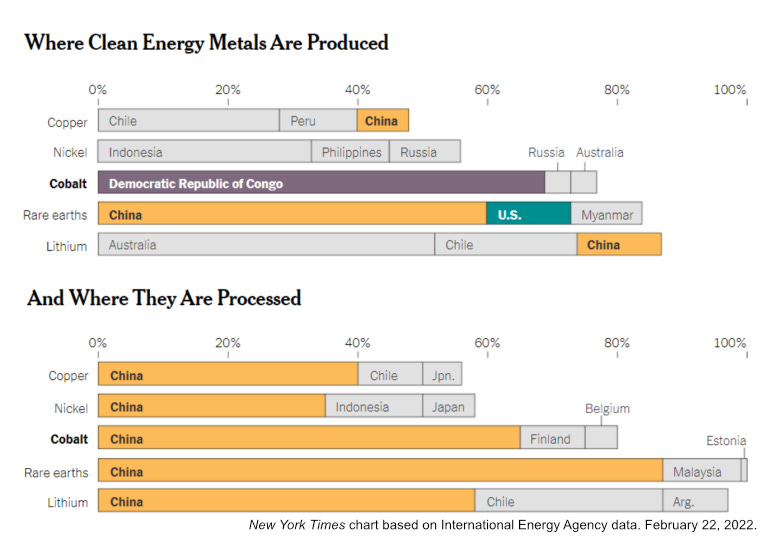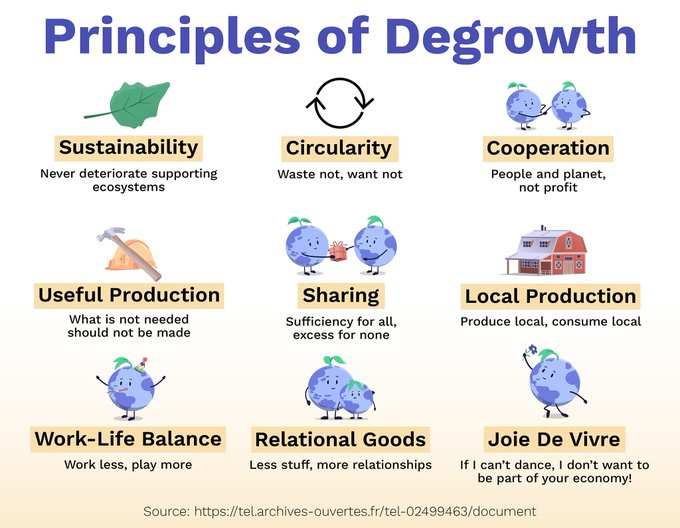Last week we continued our multi-week review of the study by Hansen et al, Global Warming in the Pipeline, forecasting the course of climate change this century and added two other recent compendia of studies, both of which had concluded, ominously, that the vast majority of projections predict increases of global temperature far higher than 1.5°C.
Most of the predictions push us up to somewhere between two and three degrees of warming where it would no longer be possible to maintain global civilization as we know it today, and the worst take us above 5 degrees and human extinction by the end of the century. Hansen says the equilibrium temperature from present atmospheric pollution is 10 degrees, but it could take us a few thousand years to get there because of ocean mixing and other delaying factors.
In Davos at the World Economic Forum this month, Potsdam scientist Johan Rockström responded to a DW interviewer who asked, “Johan, do you have any good news for us?”
Well, the good news part is that we today have so many solutions—technologies, practices, systems, everything from electric mobility to wind power and solar voltaics that actually compete without subsidies with fossil fuel systems. So from a business or an economic perspective it makes sense to invest in sustainability not only to reduce risks of unmanageable damage but also because it just makes economic sense.
So that's a light in the tunnel. Another light in the tunnel and we see it very clearly here in Davos you know, the business leaders in the world across all sectors from construction, food, transport—they're all on board and seeing not only the necessity but also a value in moving in the direction of fossil fuel free, sustainable, more resilient business models.
But finally also, science is very clear and science has made tremendous advancements over the last decades and can today show you … the targets that every business [and] every nation in the world must stay within in their economic development to be able to stay safe. … My conclusion is that we can still land at 1.5 but it will certainly, unfortunately, mean a period of overshoot before we can finally stabilize at 1.5.
The challenge is that we just need to bend the global curve of emissions. Can we do that? Well, the answer is yes, if we just decide to do it.
Four years ago a research team led by Iñigo Capellán-Pérez looked at the renewables transition now underway in terms of EROI—energy return on investment. Richard Heinberg at Post Carbon Institute explained:
If societal EROI is high during and after the transition, that means energy will be easier to obtain. And with more plentiful and cheaper energy, other problems will be easier to solve. For example, cheap energy could enable the processing of lower-grade mineral and metal ores in larger quantities, thereby making it cheaper to manufacture renewable energy components and install infrastructure. However, if societal EROI declines, most industrial and economic problems become harder to solve—whether they involve manufacturing or resource acquisition.
Currently, the world gains 12 units of energy for every unit of energy invested (drilling wells, mining coal, etc.) Renewables have EROI payback of between 3 and 5 units, partly because of the increased need for energy to build new energy infrastructure. The researchers reported that “the production of energy would need to increase by 35% in order to supply the same level of net energy to society during the transition.” They also found that greater requirements for raw materials would surpass current mineral reserves for tellurium, indium, tin, silver, and gallium.
Heinberg worries:
The implications of the study are startling. If society pursues a fast transition away from fossil fuels and toward renewable energy alternatives while attempting to maintain current levels of energy usage for other purposes (agriculture, manufacturing, building heating and cooling, road and building construction, and transportation), energy systems will be strained, possibly to the breaking point. Indeed, under conditions of declining EROI and resource scarcity, the transition might fail and industrial societies might find it difficult to stave off collapse.
A more recent study published in Nature in November 2022 supported this analysis. It found that “the initial push for a transition is likely to cause a 10–34% decline in net energy available to society.” Moreover, the cumulative carbon emissions associated with rapid transition are likely be substantial, 70-400 GtCO2 added to the atmosphere compared to current fossil emissions of about 50 GtCO2/y. Electric cars are not carbon neutral.
Heinberg breaks down the implications:
This finding means that, if society’s overall emissions are to stay within the budget permissible to limit global warming to 1.5 degrees, the rest of society (i.e., sectors other than the energy industry) will have to reduce emissions, perhaps effectively to zero. How this could be accomplished for sectors such as aviation and the steel and cement industries is barely imaginable. Unless we figure out how to reinvent many key industrial processes, they’ll simply have to be significantly downsized.
Tverberg’s Revenge
For the past 30 years, energy actuary Gail Tverberg has been warning her readers that collapse is imminent. Failing to grasp that climate change is the one ring that rules them all, she prefers to blame the Korowicz Crunch, Peak Oil and the Ponzinomics that permits fracked oil and gas to sell below production cost. In a post to Our Finite World on January 9, she says that the world economy is facing a very different problem in 2023 than it had in 2005 and predicts a discontinuity in ’23 or ’24 at the latest. She offers several promising avenues to make the economy more efficient and squeeze out unsupportable energy load. As I look around, I observe that many of these are already well underway:
Regionalization not globalization
Eliminating the trade advantage of the world’s reserve currency
Localizing vacations
Shrinking the number of banks, insurance companies and pension programs
Cutting pensions, unemployment insurance and guaranteed disability compensation
Decentralizing and digitizing higher education
De-socializing and cutting access to healthcare, especially for people who have no hope of ever re-entering the workforce
Encouraging uncontrolled epidemics, reduced quality of food and water, and a general increase of mortality across the board
Putting up barriers to migration and increasing migrant mortality
Fewer single-use items, more durable goods
Recycling and reuse
The Nature study’s authors are perhaps a bit more optimistic. They conclude:
A good life could be achieved at lower per capita energy use by … shifting from consumption choices with higher energy intensities to choices with lower energy intensities (e.g. from cars to bicycles), and by avoiding the most inefficient alternatives altogether (e.g. flying).
Even as we simplify our lifestyles, shaming private jets and gas stoves, we’ve still left ourselves and our children with the Herculean task of removing very large amounts of carbon dioxide in an effort to pull temperatures back down, post overshoot.
The trouble is, there's no sign of a genuinely globally coordinated effort to achieve those goals. Conflicts, fuel crises, and political polarizations all over the world are leading us in the opposite direction.
As Tverberg points out, we humans can get along for a while with less food (our source of energy), but we will lose weight.
Without enough food, we are more likely to catch illnesses. We might even die if the lack of food is severe enough.
The world economy can perhaps get along with less energy for a while, but it will behave strangely. It needs to cut back, in a way that might be thought of as being analogous to a human losing weight, on a permanent basis.
Dave Borlach, who puts out a weekly YouTube video on the change underway, Just Have a Think, nags:
If we'd started doing all this back in the mid-80s when people like James Hansen, Carl Sagan and Al Gore were setting out the size of the problem in no uncertain terms to members of the United States Congress then we could have implemented extremely modest carbon reductions of only about one or two percent a year and that would have been enough to have completely avoided the serious predicament we now find ourselves in.
Can Renewables Save Us?
In a recent episode of The Great Simplification podcast, oil analyst Art Berman mused,
Berman: Well, I'm really curious about when the world will realize that all of the alternatives to oil are basically only good for electric power generation, and electric power generation is a relatively smaller portion of the total energy consumption that we have. And so, I'm not, again, being critical or saying anything other than observation. And that is the fact that people think that somehow renewable energy is going to solve everything we've been talking about, it's simply not true, it cannot.
We can't do all the things that we need to do in our civilization just with electric power. And so, in a way, we're solving the easy part of the problem and convincing ourselves that once we finally get it right, we’ll have the whole thing solved. And again, I'm all for renewable energy. I’m totally in favor of renewable energy, but it's simply not going to solve any of the stuff we've been talking about today.
Nate Hagens: Well, I agree with that. In my writings, I say renewable energy can power a great civilization, just not this one.
The bumpy ride we are experiencing with atmospheric rivers in California, record heat in Australia, and no snow at European ski resorts is just a prelude to what is coming soon to a neighborhood near you. Speed bumps are going to become roller coaster rides. Electricity from renewable energy will not solve that problem. If you cannot prepare entirely, at least you should forego feigning surprise.
Watch the WEF-Davos session with Joyeeta Gupta, Johan Rockström, Yo Yo Ma, and Al Gore here.
References
Capellán-Pérez, Iñigo, Carlos De Castro, and Luis Javier Miguel González. "Dynamic Energy Return on Energy Investment (EROI) and material requirements in scenarios of global transition to renewable energies." Energy Strategy Reviews 26 (2019): 100399.
Fenton, D., The Activist's Media Handbook: Lessons from Fifty Years as a Progressive Agitator, Earth Aware Editions (2022).
Hansen, James E., Makiko Sato, Leon Simons, Larissa S. Nazarenko, Karina von Schuckmann, Norman G. Loeb, Matthew B. Osman et al. "Global warming in the pipeline." arXiv preprint arXiv:2212.04474 (2022).
Slameršak, Aljoša, Giorgos Kallis, and Daniel WO Neill. "Energy requirements and carbon emissions for a low-carbon energy transition." Nature Communications 13, no. 1 (2022): 1-15.
Steffen, Will, Johan Rockström, Katherine Richardson, Timothy M. Lenton, Carl Folke, Diana Liverman, Colin P. Summerhayes et al. "Trajectories of the Earth System in the Anthropocene." Proceedings of the National Academy of Sciences 115, no. 33 (2018): 8252-8259.
Stoddard, Isak, Kevin Anderson, Stuart Capstick, Wim Carton, Joanna Depledge, Keri Facer, Clair Gough et al. "Three decades of climate mitigation: why haven't we bent the global emissions curve?." Annual Review of Environment and Resources 46, no. 1 (2021): 653-689.
Tverberg, G., 2023: Expect a financial crash followed by major energy-related changes, Our Finite World (January 9, 2023).
Meanwhile, let’s end this war. Towns, villages and cities in Ukraine are being bombed every day. Ecovillages and permaculture farms have organized something like an underground railroad to shelter families fleeing the cities, either on a long-term basis or temporarily, as people wait for the best moments to cross the border to a safer place, or to return to their homes if that becomes possible. There are still 70 sites in Ukraine and 300 around the region. They are calling their project “The Green Road.”
The Green Road is helping these places grow their own food, and raising money to acquire farm machinery and seed, and to erect greenhouses. The opportunity, however, is larger than that. The majority of the migrants are children. This will be the first experience in ecovillage living for most. They will directly experience its wonders, skills, and safety. They may never want to go back. Those that do will carry the seeds within them of the better world they glimpsed through the eyes of a child.
Those wishing to make a tax-deductible gift can do so through Global Village Institute by going to http://PayPal.me/greenroad2022 or by directing donations to greenroad@thefarm.org.
There is more info on the Global Village Institute website at https://www.gvix.org/greenroad
The COVID-19 pandemic destroyed lives, livelihoods, and economies. But it has not slowed climate change, a juggernaut threat to all life, humans included. We had a trial run at emergency problem-solving on a global scale with COVID — and we failed. 6.7 million people, and counting, have died. We ignored well-laid plans to isolate and contact trace early cases; overloaded our ICUs; parked morgue trucks on the streets; incinerated bodies until the smoke obscured our cities as much as the raging wildfires. We set back our children’s education and mental health. We virtualized the work week until few wanted to return to their open-plan cubicle offices. We invented and produced tests and vaccines faster than anyone thought possible but then we hoarded them for the wealthy and denied them to two-thirds of the world, who became the Petri-plates for new variants. SARS jumped from people to dogs and cats to field mice. The modern world took a masterclass in how abysmally, unbelievably, shockingly bad we could fail, despite our amazing science, vast wealth, and singular talents as a species.
Having failed so dramatically, so convincingly, with such breathtaking ineptitude, do we imagine we will now do better with climate? Having demonstrated such extreme disorientation in the face of a few simple strands of RNA, do we imagine we can call upon some magic power that will change all that for planetary-ecosystem-destroying climate change?
As the world emerges into pandemic recovery (maybe), there is growing recognition that we must learn to do better. We must chart a pathway to a new carbon economy that goes beyond zero emissions and runs the industrial carbon cycle backward — taking CO2 from the atmosphere and ocean, turning it into coal and oil, and burying it in the ground. The triple bottom line of this new economy is antifragility, regeneration, and resilience. We must lead by good examples; carrots, not sticks; ecovillages, not carbon indulgences. We must attract a broad swath of people to this work by honoring it, rewarding it, and making it fun. That is our challenge now.
Help me get my blog posted every week. All Patreon donations and Blogger or Substack subscriptions are needed and welcomed. You are how we make this happen. Your contributions are being made to Global Village Institute, a tax-deductible 501(c)(3) charity. PowerUp! donors on Patreon get an autographed book off each first press run. Please help if you can.
#RestorationGeneration











Everyone needs to learn about the Heinberg Pulse and the Michaux Monkeywrench. These two objections to the mainstream notion of 'energy transition' are studiously ignored by nearly everyone. But ignoring them will not make them go away.
You can learn about them here:
Energy Transition & the Luxury Economy
https://www.resilience.org/stories/2022-10-31/energy-transition-the-luxury-economy/